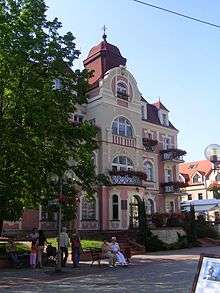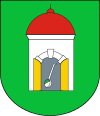Szczawno-Zdrój
Coordinates: 50°47′58″N 16°15′18″E / 50.79944°N 16.25500°E
| Szczawno-Zdrój | |||
|---|---|---|---|
|
Szczawno-Zdrój | |||
| |||
 Szczawno-Zdrój | |||
| Coordinates: 50°47′58″N 16°15′18″E / 50.79944°N 16.25500°E | |||
| Country |
| ||
| Voivodeship | Lower Silesian | ||
| County | Wałbrzych | ||
| Gmina | Szczawno-Zdrój (urban gmina) | ||
| Area | |||
| • Total | 14.74 km2 (5.69 sq mi) | ||
| Highest elevation | 430 m (1,410 ft) | ||
| Lowest elevation | 400 m (1,300 ft) | ||
| Population (2006) | |||
| • Total | 5,506 | ||
| • Density | 370/km2 (970/sq mi) | ||
| Postal code | 58-310 | ||
| Website | http://www.szczawno-zdroj.pl | ||
Szczawno-Zdrój [ˈʂt͡ʂavnɔ ˈzdrui̯] (German: Bad Salzbrunn, until 1935 Ober Salzbrunn) is a spa town in Wałbrzych County, Lower Silesian Voivodeship, in south-western Poland.
Geography

The town in the historic Lower Silesia region is situated north of the Central Sudetes mountains, approximately 3 kilometres (2 mi) north-west of Wałbrzych and 66 kilometres (41 mi) south-west of the regional capital Wrocław.
As at 2006, the town has a population of 5,506.
History
The area was settled in the course of the clearing of the former Silesian Przesieka borderland. A place called Salzborn was first mentioned in a 1221 deed, from the 14th century two settlements, Nieder ("Lower") and Ober ("Upper") Salzbrunn are documented. The parish church and a hospital at Nieder Salzbrunn were probably established by the Piast duke Henry I the Bearded after 1200, benefitting from the healing spring at Ober Salzbrunn first mentioned in 1385. Together with the Silesian Duchy of Jawor-Świdnica it fell to the Bohemian Crown after the death of Duke Bolko II the Small in 1368, held by his widow Agnes of Habsburg until 1392.
Ruled by Bohemian governors residing at Książ Castle, the area was devastated during the Thirty Years' War. It was annexed by the Prussian king Frederick the Great after the First Silesian War in 1742. Incorporated into the Province of Silesia from 1815, prior to 1945 it was in Germany (for more information about the history of the region, see Silesia). In 1935 Ober Salzbrunn was officially acknowledged as a spa town and renamed Bad Salzbrunn.

In the end of World War II, the town was occupied by Red Army forces in the course of the Vistula–Oder Offensive and fell to the Republic of Poland upon the 1945 Potsdam Agreement. The remaining German population was expelled.
Notable people
- Gerhart Hauptmann (1862–1946), playwright and writer, Nobel laureate in literature for the year 1913
- Clytus Gottwald (1925-), composer, conductor, and musicologist
- Olga Krasinska Psychologist
Surroundings
- Historical city of Kłodzko with its houses from 15th and 16th century
- Gola Dzierżoniowska Castle
- Medieval town of Niemcza
- Cistercian monastery at Henryków
- Wojsławice Arboretum
| Wikimedia Commons has media related to Szczawno-Zdrój. |



